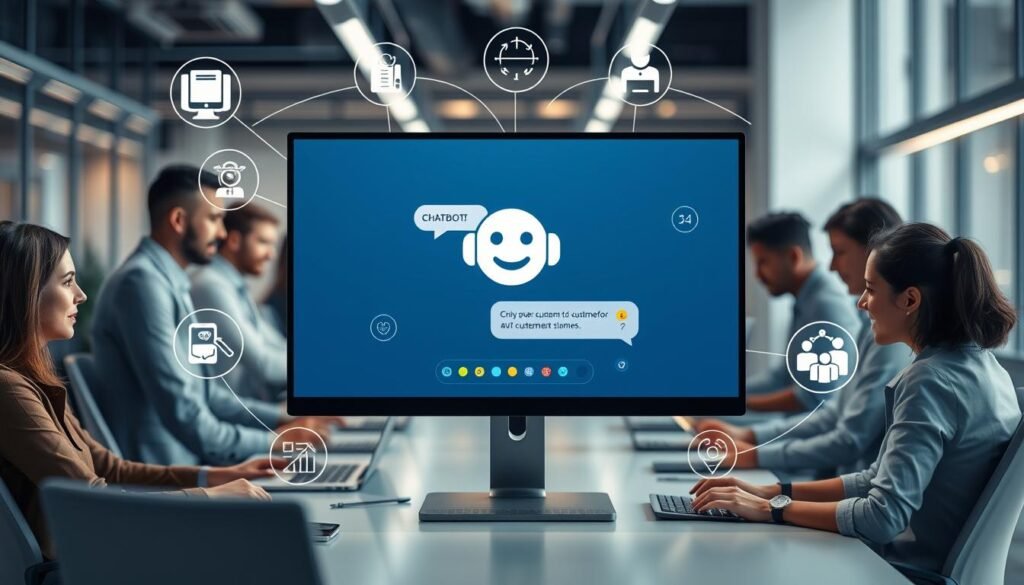Did you know AI chatbots could handle up to 85% of customer service soon? This is a big change, as Gartner1 says. Last year, 15% of Americans talked to a chatbot, showing we're getting used to AI1. Chatbots are changing how we help customers, making service better and faster.
AI chatbots can answer 70% of the same questions over and over1. They also help sell more by offering special deals. This guide will show you how to use chatbots well, making your customer service better.
Key Takeaways
- • AI chatbots can handle 85% of customer service interactions.
- • 15% of American adults utilized chatbots last year.
- • 70% of inquiries are repetitive and can be managed by chatbots.
- • Utilizing chatbots can significantly enhance the customer experience.
- • Chatbots can be instrumental in reducing operational costs.
- • They provide immediate responses, improving customer satisfaction.
Introduction to Automated Customer Support
In today's fast world, automated customer support is key to better customer experience automation. People are getting impatient, so 24/7 support is more needed than ever. Chatbot use has jumped by 92% since 2019, showing they're vital for fast, efficient help2.
Systems like chatbots and self-service portals help answer questions anytime. This lets businesses make their support smoother. Chatbots can handle up to 80% of questions on their own, cutting costs by about 30%2. They answer common questions and do routine tasks, making things more efficient and keeping customers happy.
For automated support to work well, businesses need to check how it's doing. Look at how fast they respond, how many problems they solve, and what customers say. This helps make the support better3. But, some tasks need a human touch, like dealing with emotional issues, to keep things balanced.
| Aspect | Automation | Human Support |
|---|---|---|
| Response Times | Instantaneous | Varies, longer wait times |
| Cost Efficiency | Reduces costs by around 30% | Higher operational costs |
| Emotional Intelligence | N/A | High, essential for sensitive issues |
| Task Automation | Capable of handling up to 80% of queries | Handles complex queries and escalations |
Using automated customer support saves money and makes customers happier. It helps them get quick answers.
What is a Chatbot?
Chatbots are AI programs that help with customer support by giving quick answers. They make customer service better and make support easier.
Understanding AI-Powered Chatbots
AI chatbots use natural language to talk to customers. They learn from lots of data to understand what customers mean. This makes their answers more personal and satisfying. Soon, 85% of executives think AI will talk directly to customers, showing how important AI chatbots are4.
Types of Chatbots: Decision-Tree vs. NLP-based
There are two main kinds of chatbots. Decision-tree chatbots ask questions in a set order. They're good for simple questions but struggle with complex ones. NLP chatbots, however, understand open-ended questions and can handle more tasks4.
Both types help businesses save time and money. They make sure customers get answers quickly, even when there are many questions5.
| Feature | Decision-Tree Chatbots | NLP-based Chatbots |
|---|---|---|
| Interaction Style | Scripted responses, structured conversation | Conversational, context-aware |
| Complexity | Basic queries and tasks | Complex queries, multi-step workflows |
| Use Cases | FAQs, guided troubleshooting | Personalized recommendations, autonomous service |
| Scalability | Limited by predefined paths | Handles multiple interactions simultaneously |
| Cost Efficiency | Reduces the need for additional reps | Enhances operational efficiency |
Using either type of chatbot can make customer support better. This leads to happier customers and better experiences6.
Benefits of Automating Customer Support with Chatbots
In today's fast world, chatbots have changed the game for customer support. They use AI to offer top-notch service that meets customer needs and expectations.
24/7 Availability for Customers
Chatbots stand out because they offer 24/7 customer service. This means customers get help anytime, without overloading your team. They handle simple questions, so your team can focus on harder issues.
Using chatbots means you meet the need for quick service. 90% of customers want a fast response7. Also, 62% prefer chatbots over waiting for a human8.
Enhanced Customer Satisfaction (CSAT)
Chatbots are key to increasing CSAT. Companies that use them see big jumps in customer happiness. This is because chatbots respond fast and interact in a way customers like.
70% of CX leaders believe chatbots offer personalized interactions7. This is crucial in industries with different customer styles and feelings. Chatbots also gather data to help improve strategies8.

| Benefit | Description |
|---|---|
| Cost Efficiency | Chatbots save money in service costs, letting you spend on product improvements. |
| Proactive Support | Chatbots give personalized and timely help based on customer data. |
| Scalability | Chatbots help serve more customers without needing more staff. |
| Omni-Channel Support | They assist on different platforms, creating a unified experience. |
Using chatbots for customer support brings many chatbot benefits. They improve service and build customer loyalty78.
Challenges Encountered in Customer Support Automation
Using chatbots in customer support comes with its own set of challenges. These can affect how well chatbots work and how users feel about them. It's key to know these challenges to get the most out of chatbots in customer service.
Limitations of Chatbots
Chatbots can really help with customer service, but they have their limits. They sometimes can't handle complex questions or show the right emotions, which can upset users. A big 81% of users like to solve problems on their own, showing the need for good self-service options.
But, chatbots can't always respond well to complex situations. This can cause big problems in communication. It's often because they can't deal with tough cases910.
Issues with Intent Recognition and Emotional Understanding
Another big challenge is understanding what users really want. When chatbots get it wrong, it can make things harder for customers. This can make users unhappy, especially since 33.33% of people don't like talking to customer service910.
Getting better at understanding users' needs and feelings can really help. It can make users happier and even help businesses by reducing cart abandonment and cutting down on mistakes. This shows why chatbots need to keep getting better.

Features to Look for in Customer Support Chatbots
Choosing the right chatbot for customer support is key. Look for features that make it effective. Multilingual support is a must, allowing your chatbot to talk to people in many languages. This helps reach more customers and improve their experience11.
Also, make sure your chatbot can work with your current systems through APIs. This makes everything run smoothly and boosts user happiness a lot.
Multilingual Support and APIs
For companies aiming to serve customers worldwide, multilingual support is essential. It lets your chatbot communicate in many languages, removing language barriers. Plus, using APIs lets your chatbot connect with other business tools, like CRM and ERP. This makes everything work together better and gives users a seamless experience12.
Quality Assurance and AI-Powered Insights
Quality assurance tools are vital for top-notch chatbot interactions. They check how well your chatbot is doing and offer tips for better service. AI analytics help understand what customers like and don't like, helping improve support13.
This way, businesses save money by handling simple questions automatically. They also get valuable insights to better engage and satisfy their customers.
Step-by-step guide: Automating customer support with chatbots
Starting a chatbot automation process needs a clear plan. First, set your goals. Know what you want your chatbot to do, like making customers happier or answering questions faster.
Then, find out what questions customers ask most. This helps you teach your chatbot to answer these questions well. Chatbots can handle simple tasks, freeing up humans for harder problems and better customer service14.
Choose the right chatbot for your needs. Simple questions are good for decision-tree chatbots, while more complex ones work better with NLP-based chatbots. Using a customer's name can make them feel more connected14.
It's also important to have a good knowledge base. This lets your chatbot give quick answers, making customers happier. For example, chatbots with FAQs can quickly solve problems, making customers more satisfied14.
After you start using the chatbot, keep checking and improving it. Listening to customer feedback helps you make it better. Studies show that 89% of people are willing to share their thoughts on their experiences15. Also, 77% like brands that ask for their opinions, which can make them more loyal.
Remember, while chatbots are helpful, they shouldn't replace human touch. Some people might feel upset if they can't talk to a real person15. So, it's good to have both chatbots and human support to meet everyone's needs.
| Step | Description |
|---|---|
| 1 | Define objectives for your chatbot implementation. |
| 2 | Identify FAQs and categorize them for bot responses. |
| 3 | Choose the appropriate chatbot type based on inquiries. |
| 4 | Build a comprehensive knowledge base for efficient responses. |
| 5 | Test, monitor, and optimize chatbots post-launch for improvement. |
By following this step-by-step guide, you can make a strong customer support strategy with chatbots1415.
Implementing AI Chatbots in Your Customer Support Strategy
Adding AI chatbots to your customer support needs careful planning. First, figure out what automation you need. Look at areas with lots of questions to see where chatbots can help most. Over 86% of leaders think AI can make customer service better16. Also, more than 63% of retailers use AI to improve how they talk to customers16.
Determining Your Automation Needs
Identify what's not working well in your support system. Look for slow responses and lots of questions. These are signs chatbots can help. Setting clear goals helps make your support better17. AI chatbots are always ready to help, 24/717. Since 61% of buyers want quick answers from AI, it's key to meet their needs16.
Integrating Chatbots with Existing Systems
Chatbots work best when they fit with what you already have. Bitrix24 makes it easy to add AI chatbots, offering many options and support channels17. Chatbots learn from interactions, giving you insights to improve support17. They also save money by doing routine tasks, making customer experiences better17.
About two-thirds of companies think AI can make customers feel welcome and understood. Adding AI chatbots makes things more efficient and personal16. Getting feedback from employees helps make chatbots better for customers17. Good chatbot use leads to happier employees, more trust, and reliable customer service1617.
Measuring the Success of Your Chatbot Implementation
It's crucial to check how well your chatbot works to see if it's helping your business. By looking at important metrics, you can see if your chatbot is doing its job. This helps you understand its strengths and weaknesses, making it better for your customers18.
Key Metrics to Monitor
There are key numbers to watch when checking your chatbot's success. Look at how fast it responds, how often it solves problems, and how happy users are. Also, see how many people it turns into customers19.
Watching how often people leave the chatbot for other help is also important. Seeing how often people come back shows if they're happy with it19.
By linking your chatbot to analytics tools, you can track its performance better. This lets you see what's working and what's not. It helps you make your chatbot better, giving your customers a smoother experience20.



